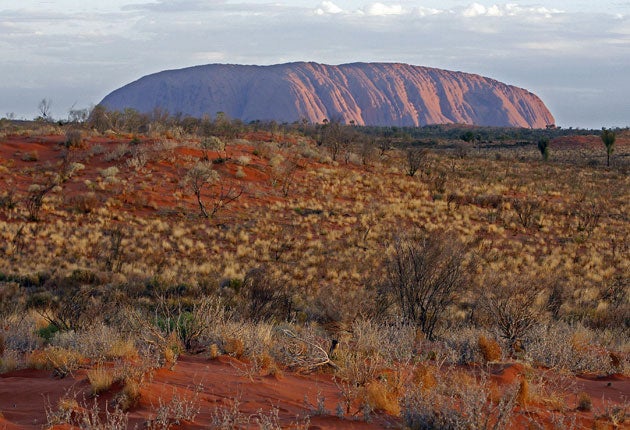Rains bring life to Australia's burning heart
Water cascades down Uluru and desert turns green after rare summer downpours

Your support helps us to tell the story
From reproductive rights to climate change to Big Tech, The Independent is on the ground when the story is developing. Whether it's investigating the financials of Elon Musk's pro-Trump PAC or producing our latest documentary, 'The A Word', which shines a light on the American women fighting for reproductive rights, we know how important it is to parse out the facts from the messaging.
At such a critical moment in US history, we need reporters on the ground. Your donation allows us to keep sending journalists to speak to both sides of the story.
The Independent is trusted by Americans across the entire political spectrum. And unlike many other quality news outlets, we choose not to lock Americans out of our reporting and analysis with paywalls. We believe quality journalism should be available to everyone, paid for by those who can afford it.
Your support makes all the difference.Uluru, the giant red rock near the geographical heart of Australia, stands in a landscape which is usually parched. But this antipodean summer, heavy rains have sent water cascading down its nearly sheer walls: a rare sight being witnessed by out-of-season tourists.
Up to 11 inches (28cm) of rain has fallen in central Australia in recent days, bringing floods to some areas and turning the desert green. At Uluru, also referred to as Ayers Rock, which usually receives little more than 12 inches of rain per year, park rangers have reported dramatic waterfalls.
Grace Moore, of the Uluru-Kata Tjuta National Park, said that flowers – not often seen in the desert landscape – were also blooming. "We're seeing the honey grevilleas flowering bright yellow, the succulents like pea-flowers are purple, and everything's turning green [including] acacias, and all the wildflowers are blooming too – it is stunning.
"At present we've got steady drizzle and, with low-hanging cloud, Uluru looks mysterious. It's spectacular."
Punishing mid-summer temperatures in central Australia mean relatively few tourists visit the region at this time of year. While the road to a neighbouring monolith, Kata Tjuta, also known as the Olgas, has been closed because of floods, walking tracks around the base of Uluru remain open.
The track ascending the rock itself is closed, for safety reasons. Earlier this month, the federal government deferred a decision on whether to ban visitors from climbing Uluru, a sacred site for local Aboriginal people. Signs at the base ask people not to climb, but more than 100,000 of those who visit annually ignore them.
Christine Burke, the park's manager, said: "It's something that a lot of people wouldn't experience, seeing the park at this time of year when it's green, and the plants are really shooting and the flowers are coming out. After we have a good rain, it looks beautiful."
The rain has been the heaviest to fall in the region in years, and the usually dry Todd River in the Outback town of Alice Springs has been flowing strongly, reaching its highest level for nearly a decade. Forecasters are predicting a return to more familiar dry, fine conditions.
Join our commenting forum
Join thought-provoking conversations, follow other Independent readers and see their replies
Comments